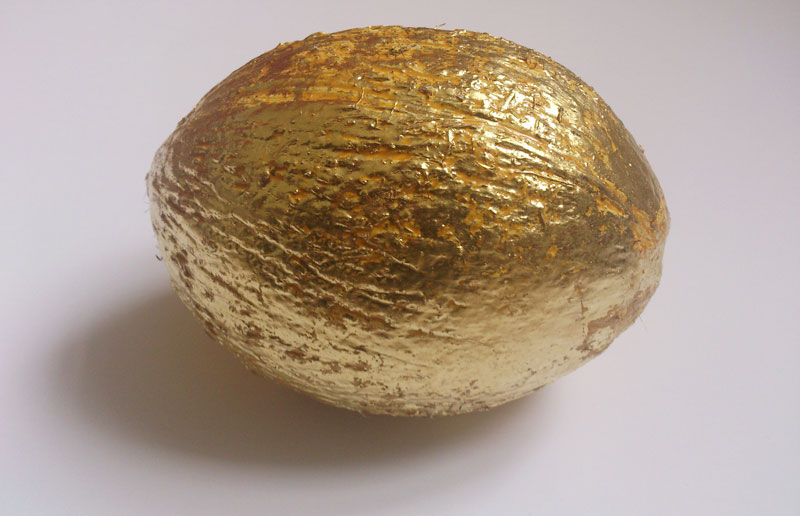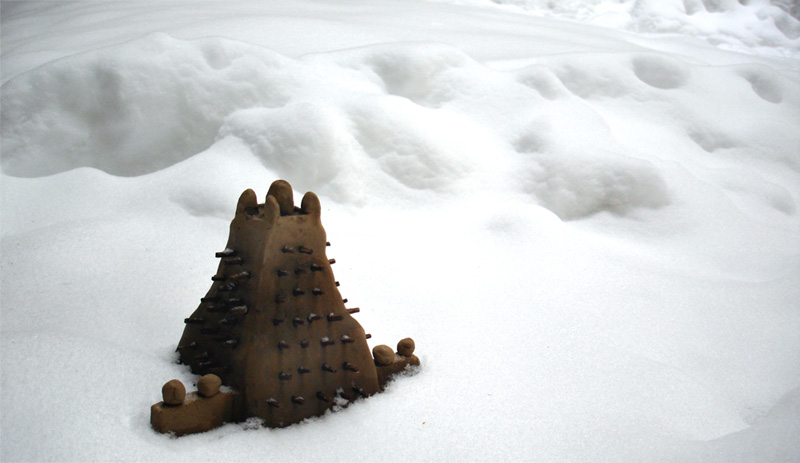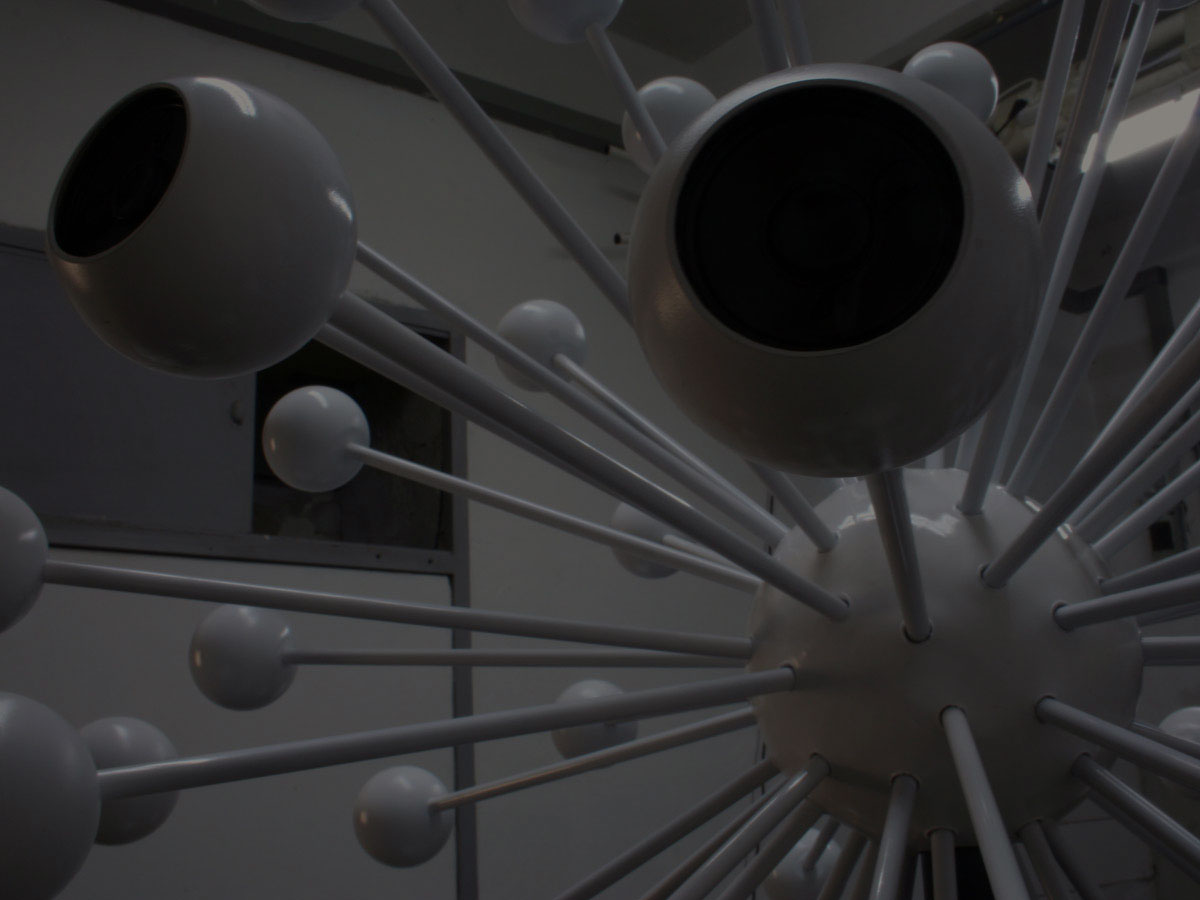Wer hat die Kokosnuss geklaut?
Projekte | projects 2012-2014

Kokosnuss, blattvergoldet | coconut, goldleafplated 2014
Die gute Nachricht zuerst; Wir wissen wer’s war.
Nun aber zur schlechten Nachricht: Es geht eigentlich gar nicht darum, wer sie geklaut hat, vielmehr richtet sich der Fokus auf den eigentlichen Akt der Entwendung.
Die Kokosnuss war kein Geschenk, sie ist ein Diebesgut…
Dabei steht die Kokosnuss nur als ein Symbol für viele Güter, die unehrenhaft entwendet werden. Denke man an all die natürlichen Ressourcen, wie fossile Brennstoffe und Wasser, die so verschwenderisch abgebaut werden, als gäbe es kein Morgen. Auch an Rohstoffe, wie Baumwolle, Kaffee und eben Kokosnüsse, deren Produktion und Handel von wenigen Mächtigen dieser Welt organisiert ist, durch deren auf Profitmaximierung bedachte Egopolitik ein guter Teil der Menschheit selbst ausgebeutet wird. Bedingt durch diesen vorherrschenden Machtzentralismus im neokolonialistischen Stile, werden Armut und Hunger als einkalkulierte Elemente zugelassen. Wenige sitzen fest im Sattel, dafür ackern Viele wie die Gäule. Die Kultur der gegenwärtigen Handelspolitik ist nicht zukunftsorientiert gestaltet, weder zum Wohle der menschlichen Rasse, noch zum Erhalt des Planeten. Der Fluch des Kapitalismus ist wirtschaftliche Expansion. Wir expandieren vom Mond zum Mars, soweit bis die Blase platzt.
Ein Teil der Gesellschaft wird mit Brot und Spielen bei Laune gehalten und eingelullt, solange es geht. Der Aufstand ist meist eine Bewegung zuviel, wenn man es sich vor dem Flatscreen bequem gemacht hat.
Sollten die vorherrschenden Gesellschaftsstrukturen aufbrechen und sich doch mal jemand erheben, folgen tränengasgetränkte Repression, Angst und Krieg.
Doch „Bad News are good News“, heißt es so schön.
Blutbefleckt ist sie und aus Gold, die Kokosnuss. Zudem eine wirklich gefährliche Frucht, der im Schnitt jährlich 150 Menschen zum Opfer fallen.
Es ist eben nicht alles Gold, was glänzt.
Im Zuge dieses Projektes sind Graphiken, Objekte und Installationen entstanden, die sich mit diesem Thema auseinandersetzen. Beispielsweise die druckgraphische Serie „les enfants terribles“, oder auch das Projekt „Klimaflüchtlinge“ stehen in Zusammenhang mit diesem Projekt.
Who has stolen the coconut?
The good message first, we know who it was.
The second message is the bad one: it is not really important who stole the coconut but much more important is the act of stealing, the focus is to be put on that. The coconut was not a present, it is a stolen good…
The coconut just stands as a symbol for many goods that are purloined in a dishonourable way.
We think of all the natural resources, like fossil fuels and water, that are used in such a wasteful way as if there were no tomorrow. Also raw materials like cotton, coffee or the mentioned coconuts are produced and traded by a few powerful and influential in this world. The result is that a major part of the world’s population is exploited by “ego-policy” concentrated on profit-maximization. Due to this neocolonial style in thinking, poverty and hunger are admitted as calculated elements in the predominating centralization of power. Those few are sitting firmly in their saddles while the many slog away like workhorses. The culture of today’s trade policy is not the least designed future-orientated, neither for the wellbeing of the humane race nor for the preservation of the planet.
Economic expansion is capitalism’s curse .We expand from Moon to Mars until the bubble will burst. A part of the society is amused by bread and games and lulled to sleep as long as possible. Nobody will stand up, it being too strenuous once you are comfortably seated in front of the flatscreen. If the predominating social structures should be broken up one day, and somebody should dare to stand up, teargas, repression, fear and war will be the consequence.
Yet, “Bad news are good news” is a beautiful saying. Bloodstained and golden is the coconut. And in addition, a really dangerous fruit, responsible for more than 150 fatalities per year.
What do we learn: all is not gold that glitters!
In the course of this project graphics, objects and installations are created tackling this topic. Examples are the printgraphical series “les enfants terribles” or the project “climate-refugees” that are connected with this project.

„Timbouctou en hiver“ Objekt, Lehm | object, clay 2013
related work:
